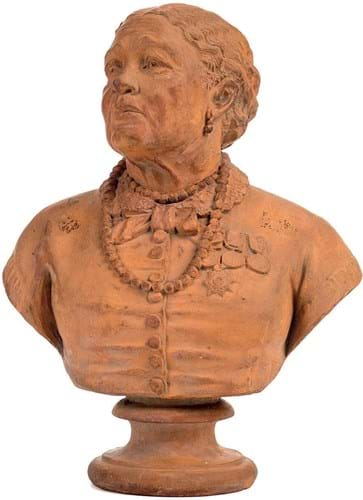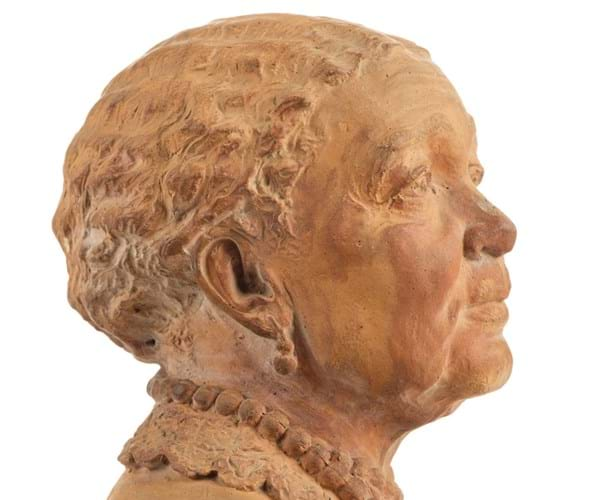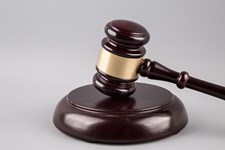Bidding at the South Cerney auction house began with 12 phones competing for the sculpture of Seacole, who nursed soldiers during the Crimean War.
It eventually came down to a final contest involving underbidder Art Aid and film producer Billy Peterson of Racing Green Pictures, which is currently filming a biopic on Seacole’s life.
Peterson will use the bust as a prop in the film. It will then be donated to the Mary Seacole Trust and be on view at the Florence Nightingale Museum.
The hammer price of £101,000 (plus 24% buyer’s premium inc VAT) at the July 30 sale (against an estimate of £700-1000) took the auction house hugely by surprise.
Chris Albury at Dominic Winter said: “Needless to say, we are in shock. We had thought it might go over £20,000 but we are as flabbergasted as the vendor.”
Auctioneer Henry Meadows took bids in increments of £1000 all the way from £10,000 (the opening bid following interest on commission) to the hammer price of £101,000.
D-Day veteran
The bust came from the collection of the late Jack Webb (1923-2019), a D-Day veteran who became a Camden Passage antiques dealer and passionate collector of militaria and objet d’art.
Seacole (née Grant) was a businesswoman, adventurer and writer who nursed sick and dying soldiers during the Crimean War (1853-56).
Born in Kingston, Jamaica, in 1805 to a Scottish soldier father and a Jamaican mother, she married a British soldier in 1836 but he died shortly after.
Jan Marsh, curator and author of Black Victorians: Black People in British Art, said: “The emergence of this appealing portrait of Crimean heroine and nursing role model is very welcome.
“Today’s renewed interest in Black history gives Seacole’s story added resonance. An independent healer originally from Jamaica, who travelled to the Black Sea at her own expense to tend British casualties, she won the hearts of men and officers, who affectionately dubbed her ‘Mother Seacole’.”
Soldier became sculptor
The bust was modelled by artist Count Gleichen. Marsh added: “He was one of the soldiers that Seacole assisted. She fashioned a mosquito-net and then successfully nursed through cholera. He was related to Queen Victoria and later became a professional sculptor.”
Describing the bust, Marsh said it is “sensitively modelled, depicting the now elderly Seacole, detailing her lace collar, earrings, necklace and proudly worn replica medals with the affection that conveys their relationship”.
The row of pearls in the sculpture were left in Seacole's will to one of the daughters of Count Gleichen.
It is believed three versions of the sculpture could have been made and one was included in an 1872 exhibition at the Royal Academy.
Another is residing in the National Museum Jamaica.
Seacole, whose mother was well known for treating the sick in Jamaica, self-funded her trip to the Crimea after she was rebuffed by official channels.
Believed to be due to racism, Seacole was turned down by the British government to go to the battlefield and was also unsuccessful in her attempt to join Nightingale’s nursing sisters.
‘British Hotel’
Instead she teamed up with business partner Thomas Day and they travelled to the Crimea to open a restaurant which she called the ‘British Hotel’.
En route she helped the sick and wounded at Scutari in Turkey and went to Sebastopol and opened a "mess table and comfortable quarters for sick and convalescent officers", to tend to the wounded from Balaklava. She was present at the assault on the Redan on June 18, 1855, tending to the wounded, even seeking such men on the battlefield.
However, on her return to England she had to declare the company she had formed with Day bankrupt. In 1857 the firm was declared free of bankruptcy and some of her grateful and influential friends such as Major General Lord Rokeby, Sir William Russell and Count Gleichen started a fund for her. A second fund was also created to keep her comfortable in old age.
Marsh pointed out that Nightingale loathed Seacole, “for supplying brandy and other liquors to the soldiers – alcohol that was doubtless much appreciated during the bitter Crimean winter, and when no modern pain-relief was available”.
“Seacole, in turn, resented her rejection by the Nightingale team, for which she hoped to volunteer. ‘Did these ladies shrink from accepting my aid because my blood flowed beneath a somewhat duskier skin than theirs?’ she asked bitterly.”
Overlooked for many years following her death, Seacole was posthumously awarded the Jamaican Order of Merit (1991) and she is now a favourite to be the first non-white person on a British banknote.
Jack Webb’s collection of medals and militaria will be sold by Dix Noonan Webb on August 20. His archive of cased photographs of British military subjects will offered as part of the Dominic Winter Photography sale in November.



















